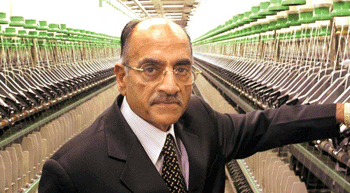
Vardhman Group: A big leap forward
Vardhman Group was ranked as the second most admired company in the Indian textile industry by Fortune India (July 2013). As one of the few ¨AA¨ rated companies by CRISIL in the textile industry, Vardhman Group has made rapid strides since its inception in 1965.
Vardhman Group was ranked as the second most admired company in the Indian textile industry by Fortune India (July 2013). As one of the few ¨AA¨ rated companies by CRISIL in the textile industry, Vardhman Group has made rapid strides since its inception in 1965. It is a fully-integrated textile player and is present across the textile value chain from yarn to fabric. In the market, it has products across 58 countries; 38.35 per cent of its 2013-14 revenues has been derived from international geographies.
Headquartered in Ludhiana, the company enjoys technical tie-ups with global leaders (Japan and Korea) for specialised yarns and fabrics. Vardhman Group´s long-term approach is reflected in its investment outlays. The company invested about Rs 3958.75 crore during FY06-14 when the global economy passed through its most challenging slowdown in eight decades. This expansion enhanced the company´s spinning capacity from 4,77,920 spindles (March 31, 2006) to 9,33,331 spindles (March 31, 2014); concurrently, the company expanded its weaving capacity from 432 looms (March 31, 2006) to 1,320 looms. The result: revenues from the spinning business increased at a CAGR of 16 per cent during FY06-14; fabric business revenues grew at a CAGR of 25 per cent during the same period. Vardhman is convinced that however unfashionable it sounds, it will continue to do what it has always done manufacture yarns and fabrics with a difference. It manufactures the widest range, the premium varieties, the best quality and the ones with the most sophisticated applications. Vardhman is driven by strategic thinking. And on some occasions opportunities arise out of its strategy.
For the first three decades of its existence, Vardhman selected to aggregate all its yarn manufacturing capacities out of a single state Punjab. Thereafter, Vardhman embarked on geographic diversification to enhance long-term sustainability. In two-and-a-half decades, the company extended to two additional states across North and Central India. Every investment location strategy, depends upon techno-economic requirements as well as opportunities created by certain states in offering benefits for investment in them.
Vardhman has selected to enter countries based on their long-term potential-ùinfluenced by that country´s captive textile resources, population growth, consumption patterns and varietal preferences-ùas opposed to short-term opportunities. This long-term approach inevitably translated into an enduring multi-country presence; the small revenue that it generated in countries with a long-term potential grew significantly over time. Its focused target strategy helped the company create a brand, sustain its presence, enhance market penetration and secure repeat business.
For instance, the company entered Japan in the late Eighties addressing niche high-end products; the island nation is now the Company´s third largest market. To address the growing requirements of speed, information, India charms with rich quality and benchmarking, Vardhman invested proactively in infrastructure, systems and certifications, while adopting tools like Quality Circles and TPM, among others. Vardhman participated in a nationwide TPM competition in 2009, the only textile company to participate. It received a gold medal in the very first year; until 2014, it had received the first prize on three occasions.
At Vardhman, every single success is appraised through a simple parameter: ¨Is it sustainable?¨ This simplified approach has helped us prioritise investments and initiatives leading to business predictability. To finance growth in a capital-intensive business, the company has relied significantly on its accruals and moderate debt. The result is that the Company has continuously expanded spinning and weaving capacities without stretching its financials.
Vardhman´s approach to fresh capacity creation is complemented by its conservative financing options.<




